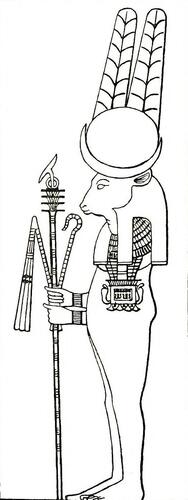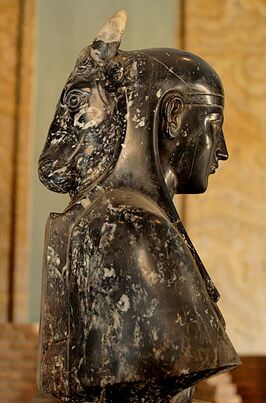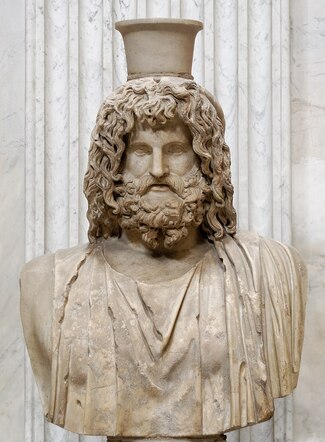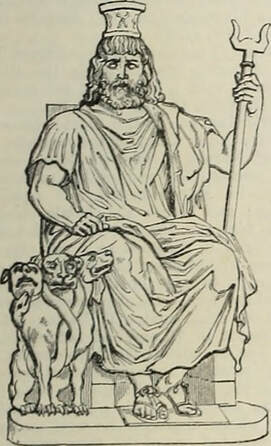Per-Wesir-Ḥapu
𓊨𓁹𓐑𓊪𓍢𓃽𓀭 𓊨𓁹𓀭𓎛𓐑𓊪𓃽 𓊨𓁹𓊹𓎛𓐑𓊪
𓎛𓐑𓊪𓅭𓊨𓁹𓊹 18thD 𓎛𓐑𓊪𓅭𓊨𓁹 𓊨𓁹𓀭𓐑𓊪𓀭
𓊨𓁹𓐑𓊪 𓊨𓃿𓁹𓎛𓅭𓊪(𓊋?) 𓊨𓁹𓀭𓐑𓊪𓊪
MDC: wsir-Hp(w); Hpw-wsir (sometimes)
Gardiner:
Budge: Ȧsȧr-Ḥāpi or Ḥāpi-Ȧsȧr
Alt Egyptian: Wsjr ḥjpj
Demotic: wsjr-ḥp
Transliteration:
Coptic: Userhapi/ ⲟⲩⲥⲉⲣϩⲁⲡⲓ
Hebrew:
Greek: Sarapis/Σάραπις (Hellenistic god), combo of "Osiris-Apis bull" (the Apis was Osiris when dying cult of Memphis), Sarapides/Σαράπιδος
Koinē Greek: Sorapis/Σόραπις , Serapis/Σέραπις
Greco-Romen: Osiris-Apis, Osorapis (Serapeum of Memphis)
French: Oser-Api , Serapis
Arabic:
English: Serapis
Kemetic:
Alt:
IPA:
Pronounced: Wesir-Hapu (typical), Usir-(h)api (more accurate)
Evolution: wsir-HAp(w) > wsjr ḥjpj > (U)siri+apis > Sarapis = (5th BCE Attic) sá.raː.pis, (1st CE Egyptian) ˈsa.ra.pis, (4th CE Koine) ˈsa.ra.pis , (10th CE Byzantine) ˈsa.ra.pis , (15th CE Constantinopolitan) ˈsa.ra.pis
Meaning: "Wesir/Osiris - Hapu/Apis (bull)" - /Wsir/𓊨𓁹𓀭 "Wesir/Osiris" /HApw/𓎛𓐑𓊪𓃒 "Hapu/Apis bull"
Gardiner:
Budge: Ȧsȧr-Ḥāpi or Ḥāpi-Ȧsȧr
Alt Egyptian: Wsjr ḥjpj
Demotic: wsjr-ḥp
Transliteration:
Coptic: Userhapi/ ⲟⲩⲥⲉⲣϩⲁⲡⲓ
Hebrew:
Greek: Sarapis/Σάραπις (Hellenistic god), combo of "Osiris-Apis bull" (the Apis was Osiris when dying cult of Memphis), Sarapides/Σαράπιδος
Koinē Greek: Sorapis/Σόραπις , Serapis/Σέραπις
Greco-Romen: Osiris-Apis, Osorapis (Serapeum of Memphis)
French: Oser-Api , Serapis
Arabic:
English: Serapis
Kemetic:
Alt:
IPA:
Pronounced: Wesir-Hapu (typical), Usir-(h)api (more accurate)
Evolution: wsir-HAp(w) > wsjr ḥjpj > (U)siri+apis > Sarapis = (5th BCE Attic) sá.raː.pis, (1st CE Egyptian) ˈsa.ra.pis, (4th CE Koine) ˈsa.ra.pis , (10th CE Byzantine) ˈsa.ra.pis , (15th CE Constantinopolitan) ˈsa.ra.pis
Meaning: "Wesir/Osiris - Hapu/Apis (bull)" - /Wsir/𓊨𓁹𓀭 "Wesir/Osiris" /HApw/𓎛𓐑𓊪𓃒 "Hapu/Apis bull"
Home:
Temple: Serapeum of Alexandria (Σεραπεῖον/Serapeion Koinē Greek, Sarapiεῖa), Iseum Campense (Rome)
Nome:
Consort
Isis (Outside Egypt)
Hera
Children
Harpocrates
Parents
Alternative Parentage
Siblings
Priest names
Followers
Features
Priest of Memphis united Wesir/Osiris (bull of the west) and Ḥapu/Apis (bull) as a god of the underworld, in Egypt he was shown as a mummified bull headed man with a lunar crescent solar disk topped with the Shuti/ two-feather crown (associated with Amun). He embodied elements of Osiris Khent Ȧmenti. He was sometimes portrayed as a two headed god man in the front and bull head in back with a tunic.
Plutarch claimed (De Iside et Osiride 28) that Ptolemy dream of a statue that he was to take to Alexandria, he was said to have found the statue in Sinope on the Pontus, The Greeks recognized the statue as Hades and the Egyptian recognized it as Wesir-Hapi/Osiris-Apis and thus Alexandria had a god everyone could worship. He was he absorbed other elements of other gods such as Zeus/Jupiter and Hades/Pluto , Demeter, Dionysus (benevolence of). He was typically shown in the Greek style with some Egyptian elements. He was shown enthroned as the guardian of the underworld similar to Hades a took on the features of Zeus, he stood for abundance and resurrection. As a Greco-romen god wears the modius, (a jar of grain-measure, a Greek symbol for the land of the dead, also part of a misunderstanding about the "canopic jars" ) on his head, sometimes with gain and corn in his hair or coming out of the Modius or curled ram horns on his head, the grain stood for fertility of the fields. He would sometimes have a Asclepius (god of medicine a snake-entwined staff/rod) similar to the Caduceus (Greek).
He is sometimes shown as a serpent with a mans head and the modius crown. The three headed dog Cerberus (sometimes associated with Anubis), often accompanies him. He is mentioned before the Ptolemaic Kingdom in 323 BC by Plutarch (Life of Alexander, 76) and Arrian (Anabasis, VII, 26, 2).
(Ref Sarapis Under the Early Ptolemies, By John E. Stambaugh · 1972, The gods of the Egyptians : or, Studies in Egyptian mythology by Budge, E. A. Wallis (Ernest Alfred Wallis), Sir, 1857-1934 p195 )
Symbols
Ram horns (curled)
Modius
Bull
Snakes
Shuti/ two-feather crown 𓋛
Roles
Ptolemy I Soter of Ptolemaic Kingdom united Greeks and Egyptians and promoted Serapis, associated god of Alexandria, god of the of Library of Alexandria. Associated with oracles Sarapin oracle/Σάραπιν χρησμό.
Hybrid gods
Sarapis Amun (Agathos Daimon)
Zeus Serapis/ Ζεύς Σέραπις
Connection to other gods
Zeus/Jupiter and Hades/Pluto (Greco-Roman gods merged)
Ea/Enki (Babylonian god) was titled Šar Apsi "king of the Apsu" or "the watery deep"
"Sar Apis" (Serapis mentioned in Babylonian Talmud)
Helios/Ήλιο (Makrovius)
Celebrations
Offering items
Protects
Other names
Οσάρ-Άπις-Σάραπις/Osar-Apis-Sarapis
Names derived from the God's name
Epitaphs
anx-wHm N ptH /The renewed life of Ptah (19th D)
Apw wHm n PtH/ Second Ptah/ (26th D)
Hp anx Wsir nb pt tm ab.f tp.f / Life of Osiris, The lord of heaven Tem (with) his horns (in) his head/ (Serapeum at Saqqara NK)
Hp wsir nTr aA xnty imntt nbt anx Dt tA / Hpi-wsir Great god, Khent Ȧmentet, the lord of life for ever(18th D)
sA ptH/ Son of Ptah




